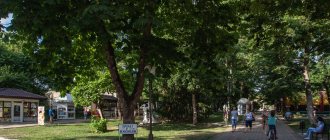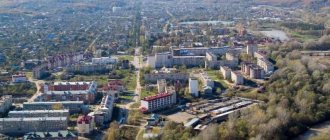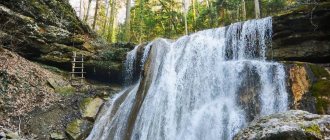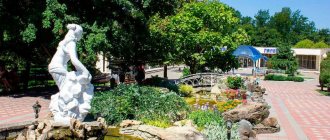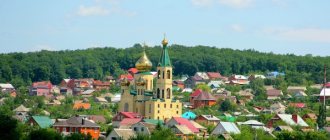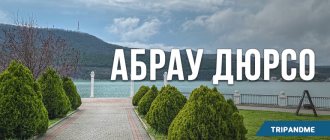Bilyarsk: areas, recreation, excursions, museums and churches, cuisine and restaurants, shopping and shops, attractions of Bilyarsk.
- Last minute tours
to Russia
It looks like Bilyarsk is a village like a village, there are dozens of them in Tatarstan. But it is Bilyarsk that stands on the site of the ancient capital of Volga Bulgaria. This is a place of power that is recognized by people of different faiths. Eight hundred years ago, the name Bilyar was borne by one of the largest medieval cities - with an area of almost 800 hectares, with a population of up to 70 thousand people. It was larger and larger than Paris and London! Bilyar was a major center of industry, crafts, trade, and culture. And in Russian chronicles it is called the “Great City”. Metallurgists, blacksmiths, masons, tanners, jewelers, carpenters lived here... Trade routes from Central Asia and Iran, Rus' and the Baltic states, the Caucasus and Byzantium converged in Bilyar. Merchants stayed in caravanserais; the ruins of one of them have survived to this day.
How to call
+7-84341 - phone number
How to get to Bilyarsk
Planes from Moscow to Kazan fly daily (Sheremetyevo and Domodedovo airports). Travel time is on average one and a half hours. Trains also run from Kazansky Station every day. You can buy a ticket for a price starting from 860 RUB (this is a seat). You will spend approximately 13 hours on the road. In the capital of Tatarstan you will need to change to a bus. It leaves from the Yuzhny bus station at 13:00 and 13:40 local time (Moscow time in Tatarstan). Prices on the page are for April 2022.
The cost of a bus ticket is about 410 RUB. From Kazan to Bilyarsk it is approximately 150 km.
Search for flights to Bilyarsk at minimal prices
Tourist streets
The following streets are best suited for walking for tourism purposes:
- Smirnova - goes along the length of the Archaeological Reserve. There are a large number of old houses on it, which, according to the state program for the preservation of Bulgarian culture, were restored at the beginning of 2010. The street bears its name in honor of the scientist archaeologist, under whose leadership many discoveries were made, artifacts of the Middle Ages were found that tell about the past of the ancient people.
- Likhachev - the outskirts of the street, where ancient buildings have also been preserved, conveying the spirit of history. The street is long, so it will require a hiker to be in good physical shape in order to cover the entire length of the walking route and see the architectural ensemble of house buildings in a short period of time.
- Gordeeva is another pedestrian street that will also be of interest to travelers visiting Bulgar for tourism purposes. This is the part of the city where the archaeological reserve originates. The largest attraction of the Bulgars. If you follow Gordeeva straight ahead and don’t turn off, then Smirnova Street begins.
Each of them is interesting in its own way, has a unique flavor, a significant number of old houses and features. It is recommended to arm yourself with a map and explore the surrounding streets, which will also be no less interesting than the walking routes described above.
Sights of Bilyarsk
It would seem, what can you see in the village?! Apart from a peaceful, idyllic picture, there seems to be nothing, but you haven’t forgotten that Bilyarsk is a village with history, and what a history! The main attraction of the village is a nature reserve, the exact name is Bilyarsky State Historical, Archaeological and Natural Museum-Reserve (Website). Its area is more than two thousand hectares, and it includes the historical and archaeological museum, the Bilyar settlement, natural landscape and historical and cultural monuments, a cemetery with a chapel-crypt of the famous organic chemist A. Butlerov, the House-Museum of Academician A. Arbuzov, architectural and religious complex "Holy Key". So you won’t be bored in Bilyarsk; you’ll hardly remember the city. One piece of advice - take a snack with you, you will have to walk a lot, and there is nowhere to eat in the reserve. The cafe is only at the entrance to the territory of the Holy Spring.
Holy Key
This is what Christians call it and it is located 3 km from the village itself. Orthodox believe that the key is “the tears of a saint that she sheds over the sins of the human race.” And the legend says: “One day a revered icon disappeared from a local church. Soon the Tatar girl saw an icon of the “Russian god” floating on the surface of a nearby lake. The girl wanted to get the icon, and the shrine itself floated to her. The icon was put back in its place, but that same night it disappeared again. And again the same girl saw her in the middle of the same lake, but the icon no longer fell into her hands. A sudden voice said to the girl: “If you want to catch me, accept Christianity.” And I myself will come into your arms and will not disappear from the church again.” The girl converted to Christianity, and local residents began to venerate her as a saint. And the place of her burial was the slope of the mountain, from under which the Holy Spring flowed.”
The Tatars call this place the Mountain of Masters, or the Master's Mountain - Khuzhalar Tavy. This holy place has been known since the 9th century. According to legend, the ancient ruler Tyryshmal Khoja had 12 daughters - beautiful and smart. One day the city was attacked by enemies, the girls and their father defended their homeland. They were captured and brought to the place where Mount Khujalar Tava now stands. The invaders ordered them to carry earth. So a whole mountain was built, on the top of which the enemies wanted to bury the father and daughters alive. But a miracle happened: the beauties turned into stars and ascended to the sky, and their father threw himself from the mountain and turned into a spring. That’s why the mountain has another name – “Maiden”. Pagans also come here - Mari and Chuvash. A spring with crystal clear and healing water united three religions at once.
Bilyarsk stands on the site of the ancient capital of Volga-Kama Bulgaria (X-XIII centuries). The Bilyar settlement is a place of pilgrimage for Christians, Muslims and pagans.
Now the area of the source is landscaped, surrounded by a brick fence made in the style of a fortress wall, and a comfortable but long staircase - 444 steps - leads to the top. There are places here designed for Muslim rituals: ritual slaughter, cooking and eating meat. In summer, the gazebos are occupied from early morning. The Orthodox have their own place for prayer and even have booths for dousing with holy water. Containers are also sold to take the water with you. On religious holidays, pilgrims at the Holy Spring become twice as many as usual, and long queues form for the life-giving water. If you find yourself at such a time, be patient and remember - it is not customary to start squabbles and dress up.
There is a belief that if you walk around the black boulders three times, your wish will come true. Try it! Also, tie a ribbon to the tree - that’s another wish.
Bilyar settlement
The ancient settlement is the archaeological remains of the capital of the Volga-Kama Bulgaria of the 10th-13th centuries. Its enormous size is amazing! And not only tourists, but also professional archaeologists. Bilyar is a whole complex of monuments, which includes the remains of fortifications, suburbs, necropolises, and country estates. This entire complex occupies about 800 hectares. According to legend, Bilyar was decorated with gates made of pure gold. There is no evidence of this yet, but archaeologists have no doubt that the Great City had a white-stone cathedral mosque, a mausoleum of the Bulgar nobility, also known as a caravanserai, a bathhouse and wells. At the same time, to date only 0.1% of the territory of the Bulgarian capital has been excavated. Using aerial photography, traces of 30 brick buildings, ancient streets, blocks, squares and reservoirs were recorded here. Scientists still have many discoveries ahead.
Archaeological Museum
A rich collection of Bilyar antiquities is kept here. You can see, for example, a metal book cover inlaid with precious stones, gold and silver temple rings with a bird in the center, bracelets made of the finest leather that once adorned the hands of Bilyar women... The museum was created back in 1977 on the initiative of Professor Alfred Khalikov. The guide will tell you in detail about national clothing, household items of the 18th-19th centuries, expensive ceremonial vessels made in Central Asia and the capitals of the Golden Horde. The story is competent and interesting - worth listening to.
Arbuzov House-Museum
Next to the historical and archaeological museum there is a museum of famous chemists, researchers of organophosphorus compounds, father and son Arbuzov. The house was dismantled and transported from a neighboring village with a curious name for a Russian person, Arbuzov Baran, where this family’s estate used to be. In the museum itself, apart from the modest life of the Arbuzov father and son, you will not see anything, unless you listen to the guide’s story about the traditions of the family, the upbringing of the future scientist, friends and achievements.
Grave of chemist Alexander Butlerov
Not far from Bilyarsk there is a small chapel-mausoleum with the grave of another famous Russian chemist, Alexander Butlerov. He loved to relax in these parts. By the way, in the Arbuzovs’ house one room is dedicated to him. Once upon a time there stood the small village of Butlerovka, no traces of it remained, only a graveyard with the grave of the rector of Kazan University. It is saved.
Local Lore Museum of Bugulma
The building was built at the end of the eighteenth century, but the museum was officially opened only in the 20-30s of the twentieth. This museum is one of the oldest in all of Tatarstan. The museum contains documents relating to all events that occurred after its founding.
There are special documents and archival materials on the Pugachev uprising, evidence of the Civil and Great Patriotic Wars, outfits of various class categories and nationalities, household utensils and other household items, as well as goods from fairs dating back to the nineteenth century. This museum will be very educational for those who are truly passionate about the history of this city and its people.
Location: Herzen Street - 88.
Volumetric urban sculpture
The uniqueness of Elista is the presence of a large number of monuments belonging to the work of various sculptors. The main idea of all memorials is to show the greatness and richness of the spiritual world of the Kalmyk people.
The sculpture “Echo” shows a musician whose body merges with the dombra, personifying the inextricable connection between culture and soul.
The Dzhangar monument is dedicated to the epic hero, hero, and defender. It symbolizes the tenacity of Kalmyks in the face of danger.
Another monument, the “Golden Horseman” at the entrance to the city, originates from the same epic.
The significance of cultural development is emphasized by monuments to famous scientists, writers and poets (A.S. Pushkin, Zaya-Pandita, P.O. Chonkushov, V.A. Khomutnikov and others).
The capital of Kalmykia, Elista, attracts tourists. There are many unique museums and monuments here. The close proximity of such different religions as Orthodoxy and Buddhism is surprising. An unusual combination of folk epic and modern heroes.
This city is definitely worth a visit to see everything with your own eyes.
Memorial of Eternal Glory
It is a memorial complex consisting of separate monuments: in front, on a small elevation, there is an eternal flame, and then there is a stele in the form of a flag, the right part of which is represented as a black mourning ribbon, and the right one contains 5560 names of heroes who gave their own lives for the defense of the Motherland and future generations from the Nazi invaders. In 2000, an armored transport and combat vehicle, the famous T-54 tank and a bomber with the inscription “Bugulma Collective Farmer” on board were fixed in front of the pedestal.
Having become more thoroughly acquainted with the history and architecture of the city, you come to the conclusion that Bugulma is one of the Russian cities that contains a huge number of monuments, steles and other buildings dedicated to the Great Patriotic War, which is so important for the younger generation to know and remember. Location: Alley of Heroes.
Location: Alley of Heroes.
Yuryevskaya Cave
Address: Tenishevo village, Kamsko-Ustinsky district Opening hours: 24 hours a day Cost: by prior arrangement with the hike organizer
The largest cave in the Volga region and at the same time the only cave open to visitors in Tatarstan, Yuryevskaya, is located in the Bogorodsky Mountains. It is a regional natural monument. The first studies in the cave were carried out in 1953. Since that time, speleologists have been clearing away the rubble in the cave (in 1971 its length increased from 20 to 360 meters, in 2009 - to 507 meters).
The cave consists of a cave-in grotto (entrance), two large halls and three manholes. The first one, the Grotto of Rains, is famous for its red stalagmite half a meter high. The second - Red Grotto - has picturesque streaks on the walls, a well and a steep vertical passage. The third hole is difficult to access and closed to visitors. And in general, the entire cave is not equipped for mass excursions; access here is open only in the format of speleo tours with the appropriate equipment.
The cave is located near the village of Tenishevo, 6 kilometers from Kama Ustye. You can get to the center of the area by bus from Kazan, and from there you can go directly to the cave.
Where is the city
Bulgar, or you can also find the name Bolgar, is a city on the territory of Tatarstan, a subject of the Russian Federation. According to the administrative division, it is the center of the Spassky district. It has the status of an urban settlement, which was built on the site of the ancient settlement of Bulgar. During the Middle Ages it was the capital city of Volga Bulgaria.
According to physical and geographical characteristics, the city is located on the left side of the Volga River coast. The capital of the Republic of Tatarstan, Kazan, is located 83 km to the south. If you move along the road, the distance between settlements is 175 km.
Golden Abode of Buddha Shakyamuni
The largest Buddhist temple not only in Elista, but also in Russia. The magnificent snow-white building will introduce guests to the basics of this eastern religion.
It is customary to distinguish seven levels (floors), which perform different roles. On the first one you can visit the museum of the history of Buddhist culture, a library and a souvenir shop. On the second level there is a prayer hall. On the third is the Elista administration, offices for receiving citizens.
The President of Kalmykia, Kirsan Ilyumzhinov, shares the fourth level of the monastery with the head of the Buddhists of Kalmykia, Tulku Rinpoche, and the monks. Above is the residence of the 14th Dalai Lama. This is followed by a utility part, above which you can find rooms for rituals. The temple is open to visitors.
The surrounding area is rich in sculptures with figures of saints. Prayer wheels can be seen here.
Location: Klykova street.
Lake Kara-Kul
Address: Bolshie Lyzi village, Baltasinsky district Opening hours: 24 hours Cost: free
Lake Kara-Kul in the Baltasinsky district can be called the Tatar Loch Ness. A local legend is associated with the reservoir, according to which a huge snake lives here. Local residents call it “su ugese”, which means “water bull”. Legends and myths have preserved for us stories about unsuccessful hunters and fishermen who disappeared in the lake area. The reason for this was the reluctance of people to make sacrifices to the owner of the lake - the snake.
In general, the name Kara-Kul can be translated as “Black Lake”. Indeed, the waters of the lake are distinguished by their blackish color (in cloudy weather, from certain points under the shade of a dense forest, the lake looks bluish-black). Perhaps this circumstance prompted local residents to think about a monster in the pond. In fact, the black tint to the water is given by the karst rocks dissolved in it, from which the shores are made.
Now Kara-Kul is ennobled. A tourist base and a boat rental point have been built here, and there are bridges along the banks. In summer, tourist rallies and other events are often organized near the lake. Fishermen love Kara-Kul for its natural resources - minnows, silver carp and carp are found here.
You can get to the lake from the villages that are located next to it. These are Bolshie Lyzi, Yarak-Churma, Nizhnyaya Sosna. A little further, 4 kilometers away is the center of the district - Baltasi, which has a bus connection with Kazan.
Churches and temples
The official religion of the Republic of Tatarstan is Islam. Despite this, Orthodox churches, temples and prayer rooms operate on the territory of Bulgar.
For connoisseurs of the spiritual aspects of life, you can visit religious attractions, namely:
- St. Abraham's Church was opened in 1988 in honor of the anniversary of the baptism of Kievan Rus. The temple was not built directly in the city. Initially it was located 15 km from Bulgar in the village of Porfirovka. The church was founded by a priest - Father Sergius. Previously, there was a small prayer house here, but through the efforts of the local community, the church was moved and is still in operation today. The temple received its name in honor of the Bulgarian martyr and saint - Abraham.
- Trinity House of Prayer is a small parish of Orthodox believers who have their own spiritual father who conducts services every Sunday, as well as on religious holidays. It is distinguished by its beautiful design, a large number of icons that were purchased or made by parishioners of the temple.
- The well of the holy martyr Abraham, who is also called the Wonderworker of Vladimir, is a source of healing water, near which a small church was built. Every believer who professes Orthodoxy can drink holy water, and then light a candle and pray.
- Assumption Church - currently, liturgies and holiday services are not held in this temple. The church is open to the public as a historical and architectural landmark. It will be of interest to tourists who are interested in the development of Orthodoxy on the territory of the oldest Muslim city in the Republic of Tatarstan.
In addition to Orthodox shrines, tourists visiting Bulgar will be interested in seeing the White Mosque. It was reconstructed in 2010 with the support of the top officials of the leadership of the Republic of Tatarstan. Additional extensions were erected to the main mosque, which replicate the architectural ensemble of Kul-Sharif. This is a mosque located in the capital of the republic - Kazan.
Raifa Monastery
Address: Raifa village, Zelenodolsk districtPhone: (84371) 3-47-59, (84371) 3-47-07 Opening hours: from 7:00 to 21:00 every day Cost: free
The largest operating monastery in the Republic of Tatarstan is located 30 kilometers from Kazan. It was erected after Ivan the Terrible captured the capital of Tatarstan. In 1613, monk Philaret built a cell on the shore of Lake Raifa. Gradually, Orthodox pilgrims and monks began to gather around him, and with their joint efforts they built a small chapel. In 1661, the monastery received a gift of a copy of the icon of the Georgian Mother of God, which is now the main asset of the monastery. The year 1689 was marked by a fire that destroyed the wooden buildings of the monastery, and at the same time the complex began to be built in stone. By 1708 a church was built, and by 1717 the construction of stone walls with towers was completed. The Georgian Cathedral was built in 1842, the bell tower in 1903, and the Trinity Cathedral in 1910.
Nowadays there is a shelter for orphans on the territory of the Raifa Monastery, and divine services are held regularly. An interesting feature of the lake near the complex are the “silent” frogs - they do not croak here. According to legend, the monks of the monastery prayed to God to deliver them from the sounds constantly coming from the shores of the lake (there are a lot of frogs here and now), which interfered with the performance of church singing. And to this day, no croaking can be heard near the monastery, and even the frogs brought from other places fall silent.
The monastery is located in the center of a village called Raifa Township (or simply Raifa). From Kazan you can get to the monastery by bus, which goes to Kulbashi or Urazly (the route passes very close to the object). Bus No. 405 goes here from Zelenodolsk.
Cities of Tatarstan
Kazan
Kazan is, first of all, a magnificent Kremlin that combines two religions (like the whole of Kazan) - the Annunciation Cathedral and the Kul-Sharif Mosque. In the vicinity of the city there is also a Temple of All Religions, which decided to unite all believers - in one building a Jewish synagogue, Orthodox and Catholic churches, a Muslim mosque, a Chinese pagoda, a Buddhist temple and other characteristic religious buildings are combined.
Chistopol
How to get there from Kazan: by bus Kazan-Chistopol from the Central bus station. Travel time is 2.5-3 hours. You can get to Chistopol by traveling by boat along the Kama.
A small merchant town on the banks of the Kama is the geographical center of Tatarstan. Chistopol has preserved the atmosphere of the district merchant towns. During the Great Patriotic War, it became a shelter for more than 200 members of the Union of Soviet Writers. Nobel Prize winner Boris Pasternak began writing the novel Doctor Zhivago here.
In 2014, the Chistopol State Historical, Architectural and Literary Museum-Reserve was created here.
What to see:
- Melnikov's House, where an art salon and a children's library are located.
- In the old mansion that belonged to the merchant A.A. Poduruev, there is an exhibition of the Museum of the county town, the pearl of which is considered to be 2 wooden bicycles, invented by a local craftsman.
- Memorial Museum of Boris Pasternak, who wrote here during the years of evacuation.
- St. Nicholas Cathedral, built with the money of the Polyakov merchants by the architect Pyatnitsky in 1838.
- Skaryatinsky Garden, which was founded in 1867 with funds from local merchants.
- Not far from Chistopol, the remains of the Golden Horde city of Dzhuketau (X-XV centuries) have been preserved.
Naberezhnye Chelny
Directly opposite Elabuga is the city where the plant that produces KAMAZ trucks is located, the Nizhnekamsk reservoir and many other interesting places.
Elabuga
Elabuga is a county town where the destinies of many wonderful people are intertwined. Shishkin painted here, Tsvetaeva wrote, and for every famous name there are museums, memorial sites, parks and monuments.
Bulgarian
Near Bolgar there are the remains of an ancient settlement, an archaeological site. Temples, mausoleums, baths, chambers and palaces - all this has come to us in the form of ruins and individual stones.
Tetyushi
Tetyushi is an interesting city in itself with old buildings, but it’s even more interesting to travel next to it. For example, to Dolgaya Polyana - a place with strange energy, from where you can clearly see the Great Bolgar.
Mount Chatyr-Tau
Address: Aznakaevsky district (7 kilometers from Aznakaevo) Opening hours: 24 hours Cost: free
The highest point of the Republic of Tatarstan is 321.7 meters above sea level. On many maps it is marked as a ridge, but in fact the mountain is an outlier that took the form of a ridge as a result of erosion of the surrounding area, and not due to tectonic movements.
The name Chatyr-Tau is translated as “tent-mountain”, and this is logical - the remnant looks like a giant green tent. From the top of the mountain you can see a panorama of the surrounding area, as well as the settlements of neighboring Bashkortostan. In 1972, the territory of the mountain and neighboring lands became a natural monument, and in 1999 - a nature reserve. At the foot of Chatyr-Tau lives a colony of steppe bobaks and the flora of the Red Book of Tatarstan grows. The mountain is very popular among fans of hang gliders and paragliders.
Direct buses run from Kazan to Aznakaevo. From the regional center itself you will have to take a taxi (there is the option of walking or traveling as part of an excursion group).
Parks
The arrangement of the city is carried out in such a way that there are no park areas in the traditional sense of the word in Bulgars. These are small green areas with broken flower beds and a small number of trees. The landscape design is more reminiscent of public gardens, where a tired tourist or an ordinary passer-by can sit on a bench and relax a little.
They are located near the following attractions:
- Museum "Bread";
- White Mosque;
- Museum of Bulgarian Civilization;
- Historical and archaeological reserve.
There is also a cozy park near the river station. You can relax in it before traveling along the Volga or immediately after arriving from an excursion trip. The squares do not have their own name.



